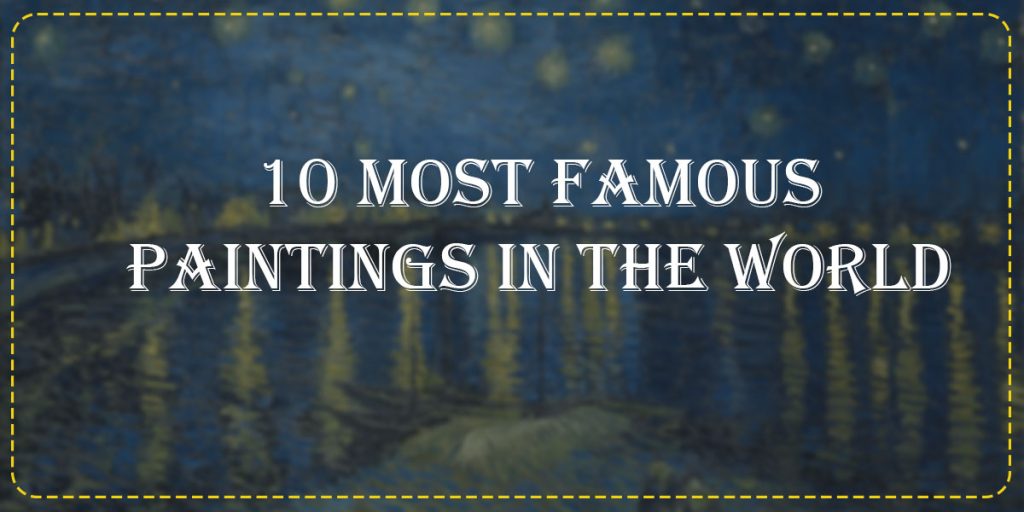10 Most Famous Paintings of all Time
Throughout history, paintings have been a form of expression, capturing the emotions and beliefs of the artist. It can evoke powerful feelings, inspire meaningful conversations and take us back in time to understand a person’s life through their artwork.
Art and painting have been around for centuries, and some paintings stand out from the rest and become world-renowned. From Mona Lisa to Starry Night, these iconic works of art have made a lasting impression on people all over the world. In this article, we’ll be discussing 10 of the most iconic paintings in history which have left an enduring legacy.
Let’s take a look at the 10 most famous paintings in the world:
1. Mona Lisa by Leonardo da Vinci (1503-1517) –
Often considered one of the greatest works of art ever created, Mona Lisa is an oil painting depicting a woman with an enigmatic smile. It was painted by the Italian artist Leonardo da Vinci between 1503 and 1517. Famous for both its enigmatic subject and for its innovative use of the sfumato technique, which creates a dream-like quality, this painting is held at The Louvre Museum in Paris and is considered a masterpiece of High Renaissance art.
One of da Vinci’s most famous works, it provides insight into the artist’s understanding of both technology and aesthetics to deliver an iconic painting. The painting has been widely acclaimed since its creation and continues to be one of the most recognizable pieces of art in all of history.
2. The Birth of Venus by Sandro Botticelli (1486) –
This iconic artwork depicts the goddess Venus arriving at the shore after her birth, with other mythological figures looking on. Painted by Italian Renaissance artist Sandro Botticelli in 1486, it is seen as a masterpiece from that era and one of the most famous paintings in history.
The painting depicts the eponymous Roman Goddess, Venus, being born from a shell after emerging from the sea. Her figure towers over several minor gods who are spectating her entrance into their world, with flowers spilling down and around her. It’s a hallmark piece of Renaissance art and its fame continues to spread around the world centuries after it was first painted.
3. The Starry Night by Vincent van Gogh (1889) –
This painting is an expressionist landscape depicting Van Gogh’s view from his room window at night, with swirling stars above a village below. Painted in 1889 by Dutch post-impressionist painter Vincent van Gogh, it has become one of his most recognizable works.
In this masterpiece, van Gogh expresses his love for nature and conveys a dreamlike landscape that was inspired by his view from outside his asylum window during the Saint-Rémy-de-Provence period. The bold brushwork and distinct use of complementary shades create an illuminating canvas full of movement and emotion beyond imagination. Although The Starry Night is known for its inspiration to millions throughout its time, it has become especially renowned today as a symbol of daring thought and creative genius.
4. The Last Supper by Leonardo da Vinci (1495-1498) –
Another masterwork by Leonardo da Vinci, this mural painting depicts Jesus Christ and his twelve disciples during their last supper before Jesus’ arrest and execution. It was painted between 1495 and 1498 and is considered to be one of the greatest religious paintings ever created.
A masterpiece of iconic artistry, The Last Supper continues to inspire awe and reverence in viewers over 500 years after its creation. Its depictions of human emotion and incredibly realistic details have earned it a spot among some of the finest works of art ever produced by human hands.
5. The Scream by Edvard Munch (1893) –
This iconic artwork depicts a figure standing on a bridge with arms raised to their face in despair or terror amidst an orange sky background filled with swirling colors. It was painted by Norwegian Expressionist artist Edvard Munch in 1893 and has become one of his most well-known works. This painting captures the feeling of utter horror and despair that many people throughout history have experienced.
It has become an iconic piece of work that is often used to portray strong feelings of fear and alienation in a world filled with chaos and uncertainty. Munch’s masterpiece conveys a clear message: no matter how alone someone may feel, they must face the bleakness of life head-on. The Scream serves as an important reminder that no matter how dark times may be, it is possible to push forward and keep going.
Also Read: Top 10 Most Beautiful Waterfalls in the world
6. Guernica by Pablo Picasso (1937) –
This oil painting, created by Pablo Picasso in 1937, stands as an iconic representation of violence, chaos, and destruction. This mural-sized painting was created by Spanish artist Pablo Picasso in response to the bombing of the Basque town of Guernica during the Spanish Civil War. It is one of his most famous works, depicting a chaotic scene with humans and animals in anguish and disarray. It serves as an excellent reminder of the tragedy suffered by the town of Guernica during the Spanish Civil War.
Despite its tragic subject matter, however, this painting has grown to become a global symbol of anti-war sentiment and peace. From being displayed at the White House to becoming an emblem for human rights campaigns and organizations, it shows that art can have a powerful influence on people no matter where they come from or what language they may speak.
7. The Sistine Chapel Ceiling by Michelangelo (1508-1512) –
This colossal painting was painted on the ceiling of the Sistine Chapel in Vatican City by the Italian Renaissance artist Michelangelo. It is one of the most renowned works of art in all of history, depicting nine panels that tell stories from the Bible. Michelangelo painted it with scenes from the Bible for Pope Julius II, who commissioned him to do so in 1508.
The fresco was intended to depict the path from man’s sin to redemption, using images from Genesis and other stories throughout Christian belief. Michelangelo worked on this masterpiece for over four years and completed it from 1512-1513. This magnificent work of art has been admired by many eyes both ancient and modern as a perfect example of Renaissance painting.
8. The Night Watch by Rembrandt (1642) –
This iconic painting is a group portrait of the Dutch militia company in 1642. Painted by Dutch artist Rembrandt van Rijn, it has become one of his most recognizable works and is considered to be one of the greatest paintings ever created. The painting depicts the company of militiamen and their captains, who are pausing momentarily during a nighttime march through Amsterdam.
Despite its large size and grandeur, some of the characters appear small in comparison to their surroundings – which serves to make them appear more realistic. While many people study this incredible painting for its complex meanings, others simply admire its content and skillful execution.
9. American Gothic by Grant Wood (1930) –
This painting depicts a farmer and his daughter standing in front of an American Gothic-style house. It was painted by American painter Grant Wood in 1930 and has become one of the most iconic works of art of all time. It shows a tight-lipped farmer, accompanied by a woman wearing a bonnet. Wood deliberately chose models from his home state of Iowa to represent rural Midwestern America at the time.
While never considered a masterpiece during his lifetime, the painting achieved fame after its 1930 exhibition and is now closely associated with regionalism in American art. Though its humor has often been misinterpreted as demeaning, its frank depictions of small-town life have increasingly gained respect over time.
10. Girl with a Pearl Earring by Johannes Vermeer (1665) –
This painting is an iconic portrait depicting a young girl wearing a blue and yellow headscarf and holding a pearl earring. Girl with a Pearl Earring, also known as “Moenie” or the “Dutch Girl”, is one of the most famous paintings in the world. It was created by Dutch painter Johannes Vermeer around 1665 and depicts a young woman with a pearl earring in its traditional Dutch setting.
The painting has inspired writers, such as Tracy Chevalier’s novel “Girl With A Pearl Earring” and its movie adaptation, and an opera written by British composer Jonathan Dove in 2007. Famous for its use of colors, light, and shading techniques, this painting captures the mystery of what lies beneath its uncertain subject’s gaze. The simplest details of Girl with a Pearl Earring are still among the most striking ever seen in art history.
These 10 paintings are some of the most recognizable pieces of artwork ever created. From the Renaissance to the modern day, these works of art have stood the test of time and continue to be admired by people all over the world. They show us that beauty is timeless and can come from any era or culture.
We are lucky to have them in our collective cultural legacy for generations to come. It also explores why these paintings remain so beloved and admired by people all over the world. By understanding and appreciating art, we can use it to come together, admire beauty, and reflect on our shared human experience.
Conclusion:
With centuries worth of artwork to choose from, selecting just 10 masterpieces can be difficult; however, these ten came out on top as some of the most famous paintings throughout history for their impactful themes, creative techniques, and sheer beauty that stands out even today! Whether you’re an art enthusiast or simply appreciate beautiful things, these ten legendary paintings will always remain timeless classics that will continue to inspire us through generations to come!







